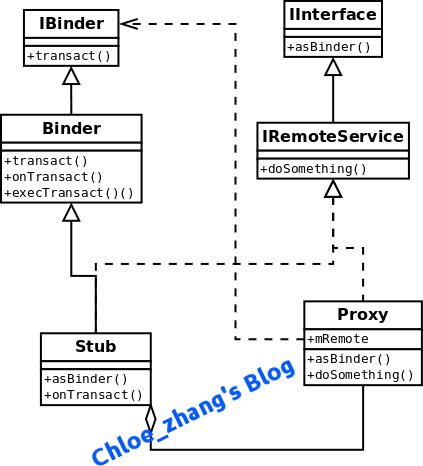Binder机制,从Java到C (1. IPC in Application Remote Service)
转载请标注:张新燕:http://www.cnblogs.com/zhangxinyan
1. Application 中的 service
我们知道Android中Service有三种类型:Local Service,Local Bounded Service,Remote Service。
Local Service:基本是提供给自已应用使用,通过startService(intent)来启动。
Local Bounded Service:也是提供给自己应用使用,通过bindService(intent)启动,然后在回调中获得service,这种service一般很少写,因为既然只提供给自己使用,又何必从回调绕个圈子呢。用第一种service就好了。
RemoteService:可以共享給更多使用者,这里就會涉及到IPC机制。在Android中,IPC机制是通过Binder来实现的。接下来就让我们开始看看Binder究竟是什么玩意吧~
2.Remote Service:
先来看看App层会遇到IPC的地方。
我们在写App时,当遇到需要在后台默默做点什么事情时,就会采用Service这个组件,当你这个Service要大公无私的向外面提供服务时,我们会采用RemoteService这个玩意。下面我们就看一下怎么样来写一个RemoteService:
1.先定義一個aidl文件:在这个文件里写上这个Service可以完成的功能接口
1 package com.example.remoteservice; 2 interface IRemoteService { 3 void doSomething ( ); 4 }
2.实现Remote Service:写一个Service组件,在这个组件里,实现Stub(Stub是啥?后面有说)的具体功能,这些功能就对应了上面aidl文件里面定义的一些接口。
接着在回调函数onBind()中把这个实现的Stub对象返回出去。那谁会来调用这个onBind()函数呢?当然是ActivityManagerService啦,有关与ActivityManagerService的详细内容会新开一篇详细说明。下面就看代码吧:
1 public class RemoteService extends Service { 2 @Override 3 public IBinder onBind(Intent intent) { 4 if (IRemoteService.class.getName().equals(intent.getAction())) { 5 return mRemoteBinder; //把一个Binder对象返回出去。其实是返回到AMS里面了。AMS:ActivityManagerService。 6 } 7 return null; 8 } 9 private final IRemoteService.Stub mRemoteBinder =new IRemoteService.Stub() {//实现Stub对象要求的方法,即AIDL的实现。 10 public void dosomething() { 11 blablabla; 12 } 13 }; 14 }
3.访问Remote Service:接着就是在Activity里面启动和调用Service的功能了,怎么调用呢?看代码:
1 public class Helloworld extends Activity 2 { 3 ... 4 @Override 5 public void onCreate(Bundle savedInstanceState) 6 { 7 super.onCreate(savedInstanceState); 8 setContentView(R.layout.main); 9 bindService(new Intent(IRemoteService.class.getName()),mRemoteConnection, 10 Context.BIND_AUTO_CREATE); // 1.触发Service端回调onBind()。 (1) 11 ... 12 mRemoteService.getPid(); //3. 会通过Binder IPC 将操作请求发送到Service端的Stub实现。 (3) 13 ... 14 } 15 16 private ServiceConnection mRemoteConnection = new ServiceConnection() { 17 public void onServiceConnected(ComponentName className, IBinder service) { (2) 18 Log.i("binder_test","IBinder service : " + service.getClass());//通过Log发现,这个service是BinderProxy object,BinderProxy是什么呢?後面再說。暂时按字面理解为Binder代理对象。 19 20 21 mRemoteService = IRemoteService.Stub.asInterface(service); // 2.通过asInterface,把Binder代理对象转化成接口。 22 } 23 public void onServiceDisconnected(ComponentName className) { 24 mRemoteService = null; 25 } 26 }; 27 }
说明:
(1) :在这里调用bindService,最后其实会调用到AMS(ActivityManagerService)中。AMS就会去查找当前系统中有没有已经启动过这个Service了,如果没有启动这个Service,就把它启动起来。然后会调用它的onBind()回调,获得Service的Binder对象。再经过一系列处理后,从调用者 Activity 的 (2)这个地方回调回来,把service传给它,当然其中对象会有一些变化,我们在回调的这个地方把返回的service打印了出来:

所以那个回调 onServiceConnected传进来的 IBinder service,它其实是一个BinderProxy!按照字面意思,我们称它为 Binder代理对象,先不管这个IBinder是来的,也不管BinderProxy到底是什么,先往下看,看下去你就会慢慢知道了。
这个对象返回到Activity中之后,通过asInterface进行一个转化,转化成了接口,其实是转化成了Proxy对象啦,Proxy对象实现了接口。
那这个转化得来的mRemoteService,我们以后就称之为 Service代理对象。
(3) :这样,获得了Service的代理对象之后,就可以通过Service代理对象调用Service的功能啦。虽然Service具体的执行是在另外一个进程,但是你是感觉不到的。
3. AIDL 工具
上面说的内容似乎有点乱,那我们整理下上面的访问过程,可以看一下下面的图:
这里面的Stub对象,Stub.Proxy对象,这些对象我们上面都没有创建吧?这些类其实都是由aidl工具自动生成的。
Client中Activity,通过bindService,触发Service回调onBind()方法,把一个Binder代理对象返回给Client。
Client通过转化,转化成一个Service代理对象,Client通过这个Service代理对象,在通过底层的Binder驱动,就可以调用进Service进程。在Service进程收到请求后,会根据里面的一个参数值,找到对应的函数,执行具体的操作。

下面这个类就是用了aidl工具后,IRemoteService.aidl自动生成的对应的类:IRemoteService.java
1 package com.example.remoteservice; 2 3 public interface IRemoteService extends android.os.IInterface { 1 4 public static abstract class Stub extends android.os.Binder implements 5 com.example.remoteservice.IRemoteService {//继承Binder,并且实现了IRemoteService接口 6 ... 7 public static com.example.remoteservice.IRemoteService asInterface(android.os.IBinder obj) {//根据传进來的IBinder对象创建一个Service 代理對象給客戶端。 8 ... 9 android.os.IInterface iin = (android.os.IInterface)obj.queryLocalInterface(DESCRIPTOR); 10 if (((iin != null) && (iin instanceof com.example.remoteservice.IRemoteService))) { 11 return((com.example.remoteservice.IRemoteService) iin); 12 } 13 return new com.example.remoteservice.IRemoteService.Stub.Proxy(obj); //看,返回的是Proxy这个对象。就是Service代理对象。 14 } 15 16 public android.os.IBinder asBinder() { 17 return this; 18 } 19 20 @Override 21 public boolean onTransact(int code, android.os.Parcel data, android.os.Parcel reply, 22 int flags)throwsandroid.os.RemoteException { //把IPC消息取出来解析,找到具体执行方法。 23 switch (code) { //根据code值,找到方法。 24 case INTERFACE_TRANSACTION: { 25 } 26 case TRANSACTION_doSomething: { 27 } 28 } 29 return super.onTransact(code, data, reply, flags); 30 } 31 32 private static class Proxy implements com.example.remoteservice.IRemoteService {//实现了IRemoteService接口 33 private android.os.IBinder mRemote; //实际上是BinderProxy对象 34 ... 35 public int doSomething() throws android.os.RemoteException { 36 ... 37 mRemote.transact(Stub.TRANSACTION_doSomething,_data, _reply, 0);//通过BinderProxy將命令发送出去。 38 …. 39 } 40 static final int TRANSACTION_doSomething = (android.os.IBinder.FIRST_CALL_TRANSACTION + 0); //这玩意就是用来区别方法的code。 41 } 42 43 public void doSomething() throwsandroid.os.RemoteException; 44 }
这里面呢,会涉及到几个类,Proxy啦,Binder啦等等,他们的关系图可以在下图中看出:

那Stub和Proxy都实现了了IRemoteService。但是呢Proxy只是把参数包装一下,通过mRemote发送出去。
Stub就是真正实现的地方了,不过这边实现的代码其实是写在Service里的,就是那个mRemoteBinder。
Proxy类是Stub的一个子类。Proxy里面的mRemote就是BinderProxy,通过它就可以把请求发送出去,然后再通过底层Binder的一些操作,最后走到Service进程里去执行一些操作。
那来总结一下吧,上面这個过程可以概括的说是:
1.Activity通过AMS的bindService(String name),让AMS做一些查找操作,然后AMS把一個service的Binder代理对象返回给Activity。
2.Activity通过一個转换,创建一個service代理对象Proxy,其是在Proxy里面,还是利用Binder代理对象向service发送命令。
下一篇会将一下AMS里面的IPC机制:







 浙公网安备 33010602011771号
浙公网安备 33010602011771号